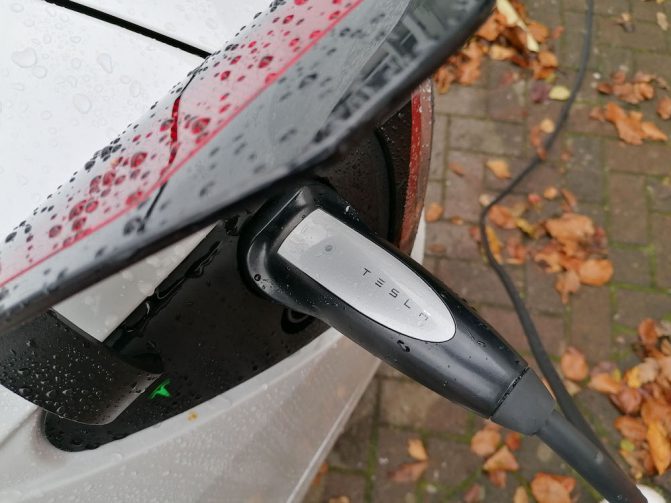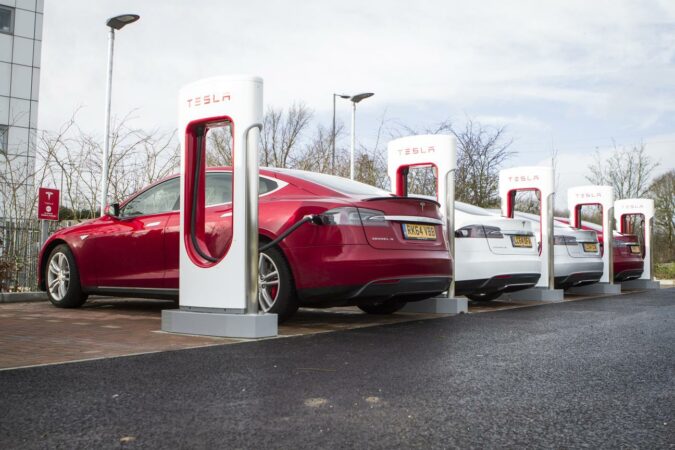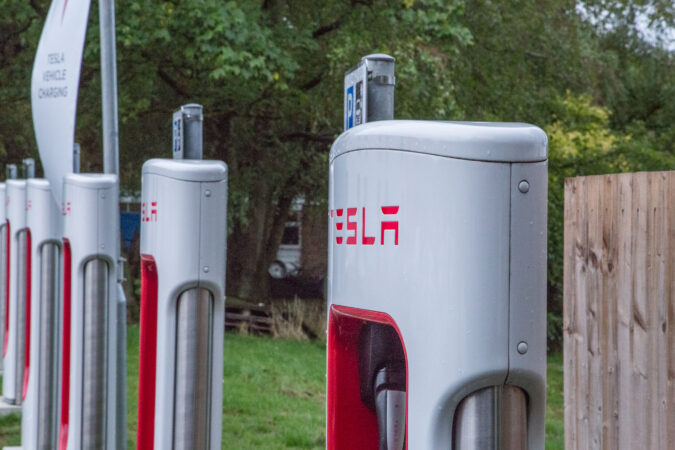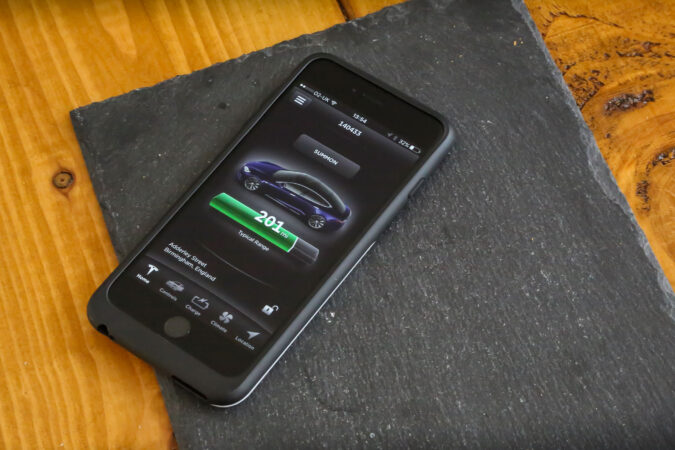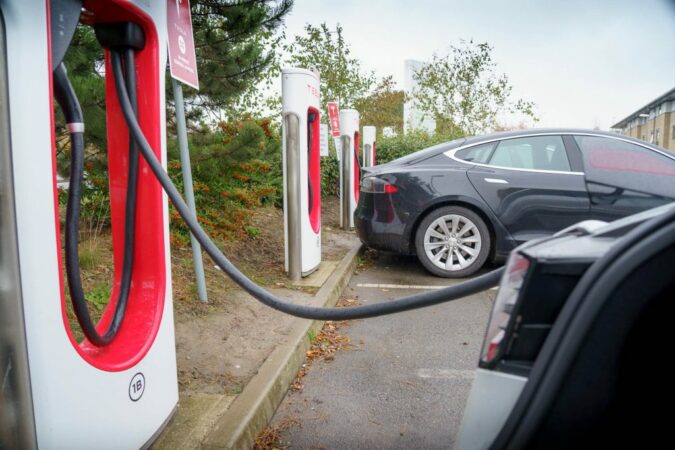Thinking of buying a shiny new Tesla? Are you wondering how long does a Tesla battery last? Well, good news, we’ll be discussing Tesla’s batteries in this post. From the technology itself to the range of various Tesla cars, and the lifespan of their batteries.
Of course, we’ll also let you know how much you may need to pay if you need to replace the battery in your Tesla. Hopefully, you’ll understand more about Tesla and its battery system by the end of this post. And maybe will help you decide on whether or not you should go electric. Let’s begin!
- How batteries in EV work
- Tesla mileage
- Tesla’s battery lifespan
- Replacement cost
- Extending battery life
- Conclusion
- FAQs
Electric Car Battery
Before we begin, we think it’ll be good if you understand the battery technology and electric vehicles as a whole. Don’t worry, we won’t get too technical and will try to keep it simple.
Electric cars are propelled by an electric motor or induction motor if you prefer the more technical term. It consists of a stator and a rotor. The stator has an AC power input which powers it and produces a rotating magnetic field.
This magnetic field then induces the rotor bars to turn, which in turn powers the wheels via its driveshaft. In between the battery and the induction motor lies an inverter, which converts the DC power output from the battery to AC power output for the induction motor.
The inverter also controls the power supply to the electric motor thus it also controls the motor speed. Here’s a great video explaining the drivetrain of the Tesla Model S. It also explains how an electric motor compares to the internal combustion engine:
So, that’s how the induction motor in an electric car works. But how does the battery work?
How Do Electric Car Batteries Work
The battery in electric cars is lithium-ion batteries, which is the same battery you will find in your smartphone or laptop. The only difference is that there are thousands of them so that you can store more energy and drive further (as you’re learning how to drive a Tesla). The battery cells are laid out in parallel, with metallic tubes between them to allow coolant to pass.
This helps to keep the batteries cool as you drive along. The battery cells and cooling tubes are arranged in a detachable module. The number of modules and cells in a battery pack varies between vehicle models. But in the Tesla Model S, there can be as many as 16 detachable modules and over 7,000 cells in a single battery pack.
Lithium-ion battery cells usually have two conductive metal surfaces, which are aluminum foil and copper. These metal surfaces allow electrical current to reach the cells. In-between lies the electrodes which are cathode (positive electrode) and anode (negative electrode), as well as an electrolyte that helps the lithium-ion carrying the battery’s charge to flow freely.
Lithium-ion batteries work through the movement of lithium ions. When you turn on a lithium-ion battery, electrons inside the anode move to the cathode via the electrolyte. This movement gives the electric motor energy to run.
Then the lithium-ions follow the electrons to the cathode, becoming positively charged lithium-ions. When you apply electricity, this process is done in reverse. The lithium ions return to the anode and become negatively charged, ready to release energy once again.
To help you understand better how lithium-ion batteries work in electric cars, we recommend watching this video:
Tesla Range Miles
The mileage or travel range in electric cars used to be atrocious. In the past, most electric cars can only travel for around 150 miles with a full charge or worse. Maybe you’ll get 200 miles on a good day.
However, the range in electric cars has been steadily improving and is now much better. Thanks to bigger battery packs, new innovations, and more efficient motors. Here is the mileage of Tesla’s lineup according to estimates from EPA:
- Tesla Model 3
- Standard Range Plus: 250 miles.
- Model 3 Long Range: 322 miles.
- Model 3 Performance: 299 miles.
- Tesla Model S
- Long Range Plus: 402 miles.
- Model S Performance: 348 miles.
- Tesla Model X
- Long Range Plus: 351 miles.
- Model X Performance: 305 miles.
- Tesla Model Y
- Long Range Plus: 316 miles.
- Model Y Performance: 315 miles.
The mileage varies between each car due to different motors and battery sizes. The Model S and X are bigger than the Model 3 and Model Y, so Tesla can fit in a bigger battery pack which gives you more power and therefore more range.
Some Tesla models also only use one electric motor instead of two or more, meaning they’re less powerful but require less energy. Additionally, your driving style will affect the range. If you need to learn more, check out our explainer on how reliable are Teslas.
Keep in mind that your mileage may be lower. Mileage claims and estimates often come from tests in a controlled lab. These tests often test out cars’ mileage at ideal speeds and without real-life traffic, which of course is the ideal driving condition.
However, in the real world, you will encounter traffic, stop-start conditions, and of course use features like air-conditioning and audio, which of course uses the battery. It’s not uncommon to find reviewers saying that their real-life range is less than the claimed range.
Tesla Battery Life
Batteries are consumables, meaning they degrade over time and will need to be replaced. Just like the batteries in your smartphone or your laptop, the batteries in a Tesla will lose their ability to store energy.
Over time, it will hold less charge than it originally did when new, and at some point, you will need to replace them altogether. We’ll get to why batteries degrade in a minute, but first, let’s talk about the lifespan of Tesla’s batteries.
A Tesla battery will lose around 4% of its charge capacity after about 100,000 miles. At around 160,000 miles, it’s estimated that it will degrade at around 10%. And after about 500,000 miles, it will degrade at about a 20% rate.
This means after 500,000 miles, the battery in your Tesla will hold 20% less charge than it originally did. So even if you charge it to 100%, it will only store about 80% more energy than it did when new.
Tesla claims that its battery will last for around 300,000 – 500,000 miles. Of course, this is just secondary research, I would be keen to see a 500,000-mile Tesla and learn if this is true in real life.
How Long Does A Tesla Battery Last: EV Batteries vs Internal Combustion Engines
The battery is how electric cars store their “fuel”, so if we want to compare it to internal combustion engines, we need to compare it with the lifespan of their fuel tanks. However, most cars now use HDPE fuel tanks, and they can easily last more than 10 years.
Most fuel tanks will last through the vehicle’s lifespan. Often you will only need to replace them when there’s a crack or if it’s been damaged in an accident. So, cars with ICEs win this round.
However, if you compare the lifespan of batteries to the engines themselves, then it’s a bit of a different story. Most internal combustion engines are rated to last for about 200,000 miles or more if you’re lucky. Most engines will need a rebuild once it reaches that mark. Or at least, it will need a major and expensive service.
On the other hand, Tesla claims its batteries will last for at least 300,000 miles. Additionally, you don’t actually need to replace the battery even if it degrades. There will be a point where you will need to replace the batteries, but even at 20% degradation, you will unlikely need to replace them. It just means that your car won’t hold as much charge and you will have less mileage even with a full battery.
How Long Do Tesla Batteries Last
A battery produces energy by releasing electrons from the cathode into the anode, this is the movement that produces energy. The lithium-ion then follows but is then converted into positive energy since the electrodes aren’t there.
When the battery is charged, the lithium-ion returns to the cathode and reunites with electrons, and becomes negatively charged. Once the process is done, the battery is ready to repeat the process and discharge energy. This process is referred to as the charge cycle.
In simpler terms, the charge cycle is the complete drainage of a battery. If you discharge a battery to 0% and then recharge it back to 100%, then you’ve completed one battery charge cycle.
A charge cycle can also be completed by using 50% of the battery, and then recharging it to 100%, and then repeating this process. When you repeat the process, degradation will happen, which reduces battery life. There are four main reasons for battery degradation:
How Long Does A Tesla Battery Last, Degradation #1: Loss Of Lithium Ions
During the charging and discharging process (for more insight, check out our guide on how long does it take to fully charge a Tesla), lithium ions may be lost through side reactions that occur with the electrolyte which traps the lithium. This will then reduce the number of lithium-ions that can travel freely between the cathode and anode. As a result, your battery won’t have as much charge.
How Long Does A Tesla Battery Last, Degradation #2: Damage To The Cathode
In addition to the trapped lithium ions, the process above will damage the cathode on lithium-ion batteries. As the cathode degrades, its ability to store lithium ions will also reduce. Fewer lithium ions lead to less power the battery can hold.
How Long Does A Tesla Battery Last, Degradation #3: L0ss Of Electrolytes
A common misconception is that cold temperatures will degrade lithium-ion batteries. However, cold temperatures do not degrade the battery, it simply makes the battery less efficient and loses power more quickly.
This happens because lithium ions cannot move as quickly between electrodes when the battery is cold. As a result, the electrical current that the lithium-ion battery produces cannot keep up with demand, making it less efficient and dying more quickly.
On the other hand, high temperatures will damage your battery and shorten its lifespan. This is because the electrolytes in the battery break down at higher temperatures. When the electrolytes break down, their ability to transfer lithium ions between electrodes will reduce.
When the electrodes lose lithium ions, they will store less energy. This is why it’s a good idea to keep temperatures low when using anything that’s powered by a lithium-ion battery.
How Long Does A Tesla Battery Last, Degradation #4: Overcharging Or Trickle Charging
We’ve all done it: plug our phone before we go to bed, and then leave it overnight and in the morning we’re greeted with a 100% charge. While this is great as you don’t have to worry about leaving the house with a low battery, leaving your device (and car) to 100% charge overnight, every night can damage the battery.
This is known as trickle charging, the process where the battery is continually charged to 100% every time it loses charge. This bouncing back between 100% and a little under 100% can cause a rise in temperature, which as mentioned will degrade the battery’s electrolyte leading to less charge being held.
Best not to leave your car or electronic device to charge to 100% overnight. You can program a charge limit on your Tesla to stop the car from charging at 80% and only fully charge for long journeys.
If you want to learn more about lithium-ion batteries and why they degrade, we recommend reading this article from Air Quality News.
Tesla Battery Replacement Cost
So, what if you were to buy a Tesla, and a few years down the line you noticed the battery isn’t holding as much charge? Elon Musk indicated in a tweet that you will only need to replace the battery module, not the entire pack itself.
As mentioned earlier, the battery module is a series of battery cells laid out in parallel. It’s possible that when Tesla’s battery degrades, only a few of the modules have actually degraded, while the others are still in good condition thus you won’t need to replace the entire pack.
Elon Musk suggested that the battery module will last anywhere between 300,000 to 500,000 miles or around 1,500 charge cycles. When a module goes bad, a replacement will set you back around $5,000 to $7,000. This number probably depends on which Tesla model you have.
However, if for some unfortunate reason you need to replace the entire battery pack in your Tesla, then be prepared to shell out some very serious money. A service invoice from Current Automotive shows that a battery pack replacement for a Tesla Model 3 costs $16,000. It’s safe to assume that larger Tesla models with bigger battery packs will cost even more than that.
In comparison, an engine rebuild is usually between $5,000 to $7,000. About the same as a battery module replacement, and much cheaper than a battery pack replacement.
Tesla Battery Warranty
If you’re surprised by the monumental amount of money you need to shell out to fix a battery in electric cars, worry not. All Tesla models come with a battery warranty:
- Tesla Model 3: 8 years or 120,000 miles.
- Tesla Model S: 8 years or 150,000 miles.
- Model X: 8 years or 150,000 miles.
- Model Y: 8 years or 120,000.
All of Tesla’s cars come with a warranty that’s valid for eight years or around 120,000 to 150,000 miles (whichever comes first). So if you’re buying a brand new Tesla, you don’t need to worry as it’s likely that you’ll still be covered by the warranty if anything goes wrong with the battery.
How To Extend Battery Life
Now that you know how long a Tesla’s battery lasts and how expensive it can be to replace them without the warranty, what can you do to extend the life of your Tesla’s battery? Well, here are some tips to do that, and of course, these tips apply to any device you have that uses lithium-ion batteries:
1. Minimize High Temperatures
As mentioned, heat will degrade your car’s battery and reduce its lifespan. You can minimize exposure to high temperatures by parking your car indoors whenever possible. Or at least, park in the shade.
Getting your car out of the sun will prevent the batteries from heating up. This is advisable especially if your car is being charged, as charging will elevate the battery’s temperature, and parking it under the sun won’t do it any favors.
2. Avoid Using Fast Charging
Fast charging is very convenient. Plugin your car, have a cup of coffee, maybe read the news for 30 minutes, and you’ll have an 80% charge ready to use. This is part of the reason why Tesla is a great option, and we’ll talk about this more later on.
However, fast charging presses a lot of electrical current to the batteries and it could strain and degrade the batteries much more quickly. Best to use fast charging only in conditions where you absolutely need it.
3. Charge Between 40% To 80%
The best state for a lithium-ion battery to be in is at around 40% to 80%. Leaving batteries at extreme ends, whether it’s too empty or too full, will put more stress on the battery, leading to faster degradation.
For this reason, it’s best that you charge your electric car before the battery goes down to below 40%, or at least, 20%. And of course, don’t overcharge it as it will create heat and put more stress on your battery. Unless you’re planning to go on a long road trip, best to limit your vehicle to 80% using the charge limiter.
Should You Go Electric
Electric cars are actually not new and have been around since the 1880s. However, it’s only in recent decades that the technology has finally improved and become a viable replacement for internal combustion engines.
Of course, the technology is still somewhat in its infancy, and there are always going to be questions with new technologies. Is it reliable? Is it more functional than existing technologies?
And of course, will it be expensive to maintain? That last question can only be answered with time, as the technology hasn’t been around long enough for consumers to decide whether it’s cheaper or not to maintain electric cars.
So, should you go electric? Should you buy a Tesla if you haven’t already? Well, I personally am an old-fashioned gearhead. I like the noise and vibrations that internal combustion engines create, it’s more exciting for me and it gives me the fizz.
Even if Tesla and other electric cars can out-accelerate even the most capable supercars while carrying more passengers. A V8 or an inline-six will always be more exciting to me than an electric motor. It’s the “x-factor” if you will. However, electric cars like Tesla do have their advantages.
Advantages of Electric Cars
The eco-friendly argument is something I tend to disagree with. Battery production is not without its flaws and creates its own pollution. As for the cars themselves, it’s true that electric cars do not produce any emissions or harmful gases.
However, where does the power you use to charge your Tesla is coming from? If it comes from a windmill or a solar panel farm, then you’re using clean renewable energy that doesn’t harm the environment. This means your Tesla does not make any emissions.
However, if the electricity you use to charge your Tesla comes from a coal-powered station, then technically your Tesla is still making harmful gas emissions. Albeit, in a different way to cars with internal combustion engines. This is of course far more complex, and it’s really an argument for another day. Best to discuss this with an actual environmental expert.
Instead, let’s take a look at the advantages of electric cars: they are inherently smoother and quieter since the electric motor doesn’t really produce any noise or vibrations apart from a whining noise that you can barely hear. This makes them the ideal powertrain for luxury vehicles where manufacturers endlessly try to make engines as silent and smooth as possible.
Performance-wise they also have their advantages. While electric cars are often heavy and don’t have the mind-blowing top speed of supercars, the instant torque they produce means they accelerate much more quickly.
The battery pack is also stored low down in the middle of the vehicle, resulting in a lower center of gravity which improves handling. If you care about these things above all else, then electric cars might just be for you. So the next question is, which electric car should you buy?
Why Tesla Is A Good Option (If You’re In The United States)
Tesla is not without its flaws. The most notable problem from Tesla over the years is their build quality issues. Customers have often received cars with a badly fitted panel, bad paint job, faulty features, and more quality control issues.
For this reason, you might be wondering, are you better off with an electric car from other more established car manufacturers? Mercedes, BMW, Honda, and even Porsche have now made their own electric cars and they are all very compelling options. Sometimes with better performance, features, and definitely better build quality.
Of course, one of the reasons why people are hesitant in switching to an electric car is the range. A gas or diesel-powered car can easily do over 300 miles with a full tank of fuel.
When they run out of fuel, you can go to a gas station, spend five minutes refueling, and you’re back on your merry way. Whereas electric cars often have a lower range, and it often takes more than a couple of hours to have about 80% charge. Not to mention, charging stations are sometimes few and far between in certain areas.
This is where Tesla becomes a more compelling option, especially if you’re in the United States. Tesla has a vast network of supercharger stations in the US that can charge their vehicle to 80% in just 30 minutes.
While Elon Musk stated that these superchargers are open for other manufacturers to adapt and use, so far no manufacturer has taken up that offer, and thus only Tesla cars can use this supercharger network. This means you don’t have to worry about range or spend hours waiting for your car to recharge.
Renown tech Youtuber MKBHD discusses this in his video about Tesla and their competitors:
Electric Car Battery Life: Facts about Tesla Battery Ranges and Replacements
- Tesla cars have a range of at least 267 miles per single battery charge.
- Tesla CEO Elon Musk claims a Tesla battery lasts for 300,000 to 500,000 miles, which is around 22 to 37 years of driving for an average person.
- Model S is the Tesla model with the longest range at 375 miles per full charge.
- Superchargers can give up to 200 miles of range in just 15 minutes of charging, but fast charging strains EV batteries and can affect battery life in the long run.
- Tesla battery technology makes electric vehicles more reliable over time, with only a 10% decrease in performance after 160,000 miles.
- Battery replacement for a Tesla Model 3 can cost around $5,000 to $7,000, and labor costs range between $20,000 and $22,000.
- Charging rate depends on the EV charger used and the Tesla model.
- Maintaining a regular charging schedule, avoiding excessive acceleration, and keeping tire pressure optimal can conserve range and battery life.
- Battery range and battery life are affected by driving habits, environment, and weather conditions, among others.
- Tesla’s battery degradation is covered by a warranty that ranges from 8 years or 100,000 to 150,000 miles, depending on the model.
How Long Does A Tesla Battery Last: In Conclusion…
Tesla’s battery will last for about 300,000 to 500,000 miles. Even at that point, you will likely only need to replace the module, not the entire battery pack. This will cost anywhere between $5,000 to $7,000, but an entire battery pack is much more costly at around $16,000. That’s significantly more than an engine rebuild which is usually around $4,000 to $7,000 for most cars.
Of course, there are measures to prolong a battery’s lifespan. Additionally, Tesla provides a battery warranty for their vehicles for eight years, or around 120,000 to 150,000 depending on the model. So if anything goes wrong with the battery, you can replace them free of charge.
FAQs On How Long Does A Tesla Battery Last
If you’re curious to learn more about how long does a Tesla battery last, our FAQs here might help…
How Long Does It Take To Charge A Tesla
The amount of time required to charge a Tesla varies depending on several key factors. These include the size of the battery, the charge rate of the battery (i.e. how much % of charge do you have at the moment), and what you’re charging with. For example, let’s say that you plan on charging the average-sized Tesla battery from nearly empty all the way to full again. If you’re just plugging it straight into your regular home outlet, it could literally take you days to charge it fully. At the very least, it may take you nearly 24 hours just to charge up your car. However, using a dedicated wall charger can cut this time down to between 7 to 8 hours. On the other hand, a Supercharger will top up your Tesla’s batteries in no time flat, taking only 25 minutes to a bit over 30 minutes to fully charge.
How Much Does It Cost To Charge A Tesla
According to studies by EnergySage, the average cost to fully charge a Tesla across the US is $13.96. Although, they’ve noted that this will vary depending on the time of day you’re charging at, and the energy tariffs in your local area, among others. Therefore, the real cost to fully charge a Tesla ranges somewhere between $9.62 to $18.30. On top of that, it’ll also vary based on what you’re using to charge it. For instance, plugging your Tesla and charging it at home will cost you between $3 to $5 per 100 miles of range. A Supercharger is more expensive though, costing you around $25 to rapidly and fully charge your Tesla. As of late, and especially owing to high gas prices, charging up a Tesla or any other electric vehicle at home is found to be far cheaper than filling up a gas or diesel car.
How Much Is A Tesla Battery
Thankfully, a Tesla’s typical battery pack lasts quite a while. Some studies have shown that a lot of Teslas still have at least or around 90% of charge left after more than 200,000 miles. This is good, as a Tesla battery pack replacement is very expensive. If all you need is to replace individual battery modules rather than the entire pack, this will be somewhat cheaper. According to Tesla, a single module will cost between $5,000 to $7,000 to replace. This is costly enough, especially when you consider that a whole battery pack will cost between $20,000 to $35,000 to replace. This is more than half the MSRP of a base-level Tesla Model 3! Although, there is a cheaper option, and that’s by using remanufactured or reconditioned batteries. These will cost around $9,000 to $13,000 for the entire pack.
How Far Can A Tesla Go On One Charge
On average, most Teslas have a range of between 250 miles to 400 miles. This is dependent on not only the size of the battery but also the powertrain that it’s powering. We can note that even with larger battery packs, high-performance Teslas still have a lower range compared to their regular, non-performance counterparts. In recent years, their advancement in battery technology has allowed Tesla to offer batteries with higher ranges than earlier models. For example, most new Teslas these days would easily be able to travel upwards of 300 miles. Meanwhile, the Tesla with the highest rated range is the dual-motor Model S. In this specific trim, it’s able to travel up to around 405 miles on a single charge. However, Tesla has since been out-ranged by Mercedes and their EQS sedan.
How Many Miles Does A Tesla Last
Tesla has since cemented itself as the leader in EV tech and battery design. As such, their batteries are typically very long-lasting and durable. Most studies show that the average Tesla battery pack could last between 300,000 to 500,000 miles or more before needing a replacement. If we’d consider that the average American drives around 14,000 miles each year, this equates to about 21 to 35 years of use. Furthermore, Tesla is currently working on developing a ground-breaking new battery pack that could last for up to 1,000,000 miles. Currently, Tesla’s batteries also degrade very slowly, which is good. It’s been noted that the average Tesla will still retain at least or around 90% of its charge capacity, even after 200,000 miles of use, far exceeding Tesla’s own battery warranty.

